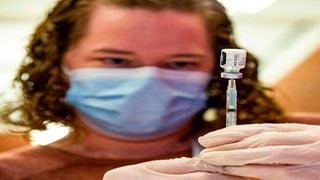
Kenya and many African countries might be failing to detect a sub-strain of the Omicron variant after experts found that it can escape detection through RT-PCR tests.
| Joseph Prezioso | AFPNews
Premium
Fresh fears of Omicron surge as countries fail to detect sub-strain
Kenya and many African countries might be failing to detect a sub-strain of the Omicron variant after experts found that it can escape detection through RT-PCR tests.
The sub-strain nicknamed ‘Stealth Omicron’ has so far been detected in 43 countries and is rapidly on the rise in the US, UK, Germany, India, France, Botswana and South Africa.
Late last December, the sub-strain, BA.2, was first identified in India and South Africa, and according to the World Health Organisation (WHO), the Omicron variant has three sub-strains, namely BA.1, BA.2, and BA.3.
The global health regulator explains that while the BA.1 sub-strain is dominant among the Omicron infections reported across the world, the BA.2 sub-strain spreads faster and is believed to have emerged from a mutation of the BA.1.
This means that while PCR tests will still spot if someone has this version of Covid-19, the samples would need to be sent for further lab analysis to determine if someone had the ‘Stealth’ sub-strain.
Not in Kenya
Speaking to the Nation, Dr John Kiiru, the head of the Department of Laboratory Services at the Ministry of Health (MoH), who is in charge of all Covid-19 screening and testing, allayed fears of the sub-variant being in the country.
“We have not seen this locally,” he said.
Asked if the tools used can detect the sub-strain, he said: “Kenya had reviewed the kits by August last year and since then, all the kits we buy can detect all variants. Our specifications define kits that target genes that are not affected by mutations."
In an exclusive interview with the Nation on Monday, Dr Nicksy Gumede-Moeletsi, the regional virologist for WHO African Region, disclosed that Africa was recording more BA.1 than BA.2 cases.
“If some of the countries within the African region are relying on RT PCR tests, they may have missed to detect the sub-lineage because BA.2 does not have the S gene dropout, unlike the main sub-lineage BA.1. It, therefore, escapes identification through RT-PCR tests,” the virologist explained.
Not easy to track
BA.2, which is not easy to track, is said to pose a number of challenges to experts.
The existing variations in PCR test protocols and considering that each test kit varies in design from one laboratory to another, makes it very tricky and difficult to identify this sub-variant.
Though WHO, which had classified Omicron as a “variant of concern” has not yet distinguished between it and its BA.2 sub-lineage, Dr Gumede-Moeletsi asked scientists and health officials to be vigilant.
“Regardless of the test results you get, take the samples for sequencing to be absolutely sure. So far in South Africa we have recorded 3,452 BA.1 cases, while BA.2 cases are now at 92, while in Botswana we have registered 1,033 BA.1 cases, BA.2 are 49, while there is only one case of BA.3,” she told the Nation.
In Britain, the government has so far confirmed 426 cases of BA.2 after conducting whole genome sequencing (WGS), with the UK Health Security Agency (UKHSA) designating the Omicron variant sub-lineage as a “variant under investigation” -- which is one level below a “variant of concern” -- after official data indicated that it may be both more transmissible and much more able to evade vaccines than previous strains of coronavirus.
Not unexpected
Dr Meera Chand, the UKHSA’s Covid-19 incident director, explained that an altered form of Omicron was not unexpected because by their very nature, viruses are constantly evolving.
“So far there is insufficient evidence to determine whether BA.2 causes more severe illness than BA.1, but data is limited and UKHSA continues to investigate.”
Scientists further observe that its ‘Stealth’ nickname comes from one of its key differences with the original Omicron, which was relatively easy to track because of a specific quirk (the deletion of a spike gene) made it stand out on the widely-used PCR tests without the need for extra genome sequencing, while the new strain does not appear to have this feature, making it more difficult to detect.
On severity, Mr Tom Peacock, a virologist at the Imperial College London, in an official tweet, noted that more data was needed.
No dramatic difference
"Very early observations from India and Denmark suggest there is no dramatic difference in severity compared to BA.1. This data should become more solid (one way or another) in the coming weeks.”
Mr Peacock went ahead to make a prediction: "Several countries are near, or even past the peak of BA.1 waves. I would be very surprised if BA.2 caused a second wave at this point. Even with slightly higher transmissibility, this absolutely is not a Delta-Omicron change and instead, is likely to be slower and more subtle."
Dr Gumede-Moeletsi asked Kenyans not to drop their guard.
“We understand the public fatigue people are facing, but it seems we are going to live with this pandemic quite longer, I urge everyone to continue to observe the measures put in place to keep them safe.
Keep washing your hands, sanitise and always have your mask on.”





